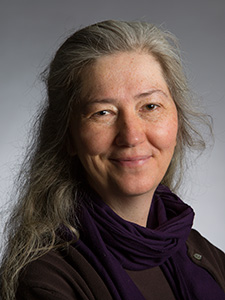Getting Into The Habitat
Laurie Eberhardt, Ph.D.
Associate Professor of Biology
Biology professor Laurie Eberhardt has found that students become more excited about learning when field projects serve communities.
Professor Laurie Eberhardt’s field biology class is somewhat unconventional. To teach ecological sampling, a traditional course would give students a worksheet and have them practice sampling certain species around the college’s campus. With this method, students practice ecological sampling, but with little sense of purpose.
Professor Eberhardt’s strategy is more sophisticated. She brings her field biology students to Shirley Heinze Land Trust, where ecological sampling is a critical part of the environmental management strategy. Like many areas of the United States, the Trust deals with an overpopulation of deer, and those deer eat the same indigenous plants that the Shirley Heinze staff is trying to protect.
“They think they have figured out how to control the deer population through hunting, but they don’t know how effective that is without monitoring data,” Professor Eberhardt says. “My classes go out each spring and see how much the deer chomped over the winter. They’re learning techniques about identifying plants, recognizing deer damage, and conducting ecological sampling. So our lab time builds those skills while collecting valuable data.”
Professor Eberhardt says the primary reason for this work is the students’ education.
“When I tell students that the data we collect is useful to the park management, the project is suddenly more engaging. They feel they are contributing, and that allows them to learn the material better,” she explains. They also get experience with environmental management, a popular career path for environmental science majors.
Professor Eberhardt incorporates service learning projects into each of her courses. In Ecology, students monitor storm water at five sites and send their data to city officials. For Science of the Indiana Dunes, students partner with scientists and land managers to determine the best methods to close “volunteer” trails, the ones where over-eager visitors have walked beyond the official trails and trampled the dunes’ natural vegetation. For Diversity of Life, students learn to monitor stream health.
After every project, a staff member from the partnering organization meets with students to thank them for their work. That networking leads to internship and job opportunities for many students.
“People get connected in ways they wouldn’t otherwise,” Professor Eberhardt says. “And these kinds of projects let students see the opportunities that are out there.”
Professor Eberhardt adds that there is one more benefit to the work.
“We are helping out in ways that show that we’re not just a closed university doing our thing. We’re using our knowledge to serve the community.”
Here, too, Professor Eberhardt is somewhat unconventional, providing community service not just to the human residents of Northwest Indiana, but to its trees, streams, flowers, and dunes as well.
Because the experiences shape future environmental scientists, these projects will go on to benefit even more communities around the United States and even the globe.
